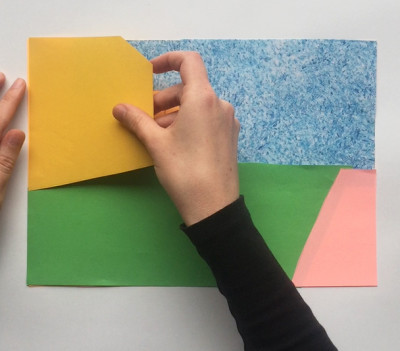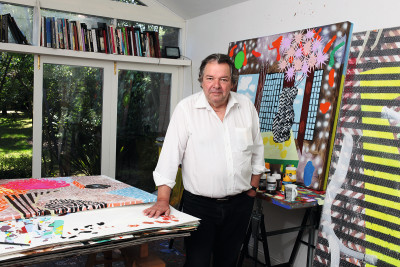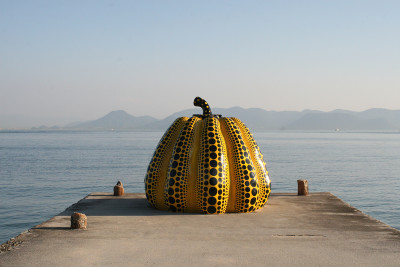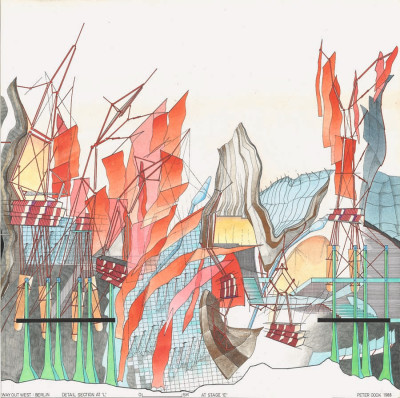
Sir Peter Cook RA and Christine Hawley, Design for Medina Circle Towers, Tel Aviv, Israel, 1997.
Print with coloured washes, coloured pencil and red plastic film. 1422 mm x 622 mm. © Sir Peter Cook RA. © Photo: Royal Academy of Arts, London. Photographer: Prudence Cuming Associates Limited.
This image is released under Creative Commons CC-BY-NC-ND
To licence this image for commercial purposes, contact our Picture Library at picturelibrary@royalacademy.org.uk
Design for Medina Circle Towers, Tel Aviv, Israel, 1997
Sir Peter Cook RA (b. 1936) and Christine Hawley (b. 1949)
RA Collection: Art
Peter Cook is a member of the Archigram Group that was formed in the early 1960s to create architectural designs based on technological considerations infused with all the fun of the Pop Art movement. Members of Archigram were celebrated for their ‘paper architecture’ because so many of their exuberant drawings seemed unbuildable. They created a science fiction world in which mankind lived, worked and enjoyed the freedom of moving about the planet in giant walking pods, or burrowed down into the earth. Yet within this visionary message, Archigram produced serious ideas about mechanised building production and design that enabled the next generation of architects to develop new forms of building, most notably in the emergence of high-tech architecture.
A working independence exists among the loose association of the group members even today, as their influence endures and inspires others. Peter Cook has become important as a teacher and spokesperson of the group’s experiences. And he has begun to build. One of his most notable works, made in conjunction with Colin Fournier, has been the Kunsthaus in Graz, Austria, a contemporary art museum completed in 2003, so unusually shaped – like an inflated bag with bright blue skin that beats with studded light from fluorescent rings – that it is affectionately called the ‘friendly alien’.
Peter Cook was elected in 2003, submitting as his Diploma Work this design for a block of flats. He undertook the project in the late 1990s with Christine Hawley, who had been a pupil of Cook’s at the Architectural Association, London, and later a partner in his practice. The
is in the style of the Archigram Group: flamboyant, quirky, vibrant. The concept is reminiscent of one of the group’s early schemes that was introduced by Cook in 1964, Plug-In City, which featured a megalopolitan city-structure, like a space station on earth, with a gigantic crane that moved mobile sections around for different facets of human living.
In 2008 Peter Cook published Drawing: The Motive Force of Architecture, a poetic, questioning and personal philosophy about architectural drawing by a master in the art. The book features drawings by Archigram colleagues and admired contemporaries as well as Cook’s own work. His Diploma Work is illustrated as a presentation drawing for client and public, a ‘propositional work’. Cook explains:
‘… I could not have imagined making the project of the Medina Circle Tower in Tel Aviv (1997) without the extensive use of colour. It is not that the sky in Tel Aviv is red; rather that the warmth of the climate and the wish to articulate the profile ran together with a semi-conscious statement about the volatility and entrepreneurship of the locals. Moreover, the red colour establishes a palette that can incorporate shades of blue, purple and a kind of pink that serve to illustrate key constituents: windows, screens, sun blinds and shadowy interior forms.
The basic position is of three towers to occupy the upmarket location of the Medina Circle in North Tel Aviv. It was originally designed with the co-operation of Oscar Niemeyer, whose intention was always that the big circle of shops and apartments contain some towers within it. So far this has not happened. My composition is of a housing tower (discretely in the rear, in pink), the vegetated racking of a parking tower and a primary tower made up of 10 different categories of entrepreneurial activity: offices, showrooms, hotels, consultancies etc. Each type with differing requirements and differing façade characteristics. Each articulated from the other and threaded together like a vertical kebab.
There are some local incidents, deviations and appendages … There is an emphasis on the glassy quality of much of the building, and the basic line drawing is mostly coloured in watercolour, which I always find to be both highly controllable and capable of reconsideration as one proceeds. It enables one to gauge the degree of contrast or the degree of “filming” over the preceding layer of colour.
Such a drawing is therefore quite conventionalised, as befits a propositional work. It is in some ways slightly overstating the situation, drawing attention to the relation between programme and form.’
Object details
1422 mm x 622 mm



